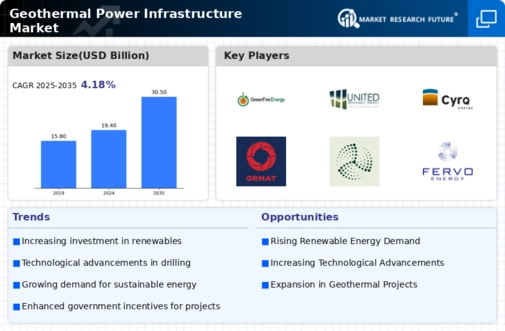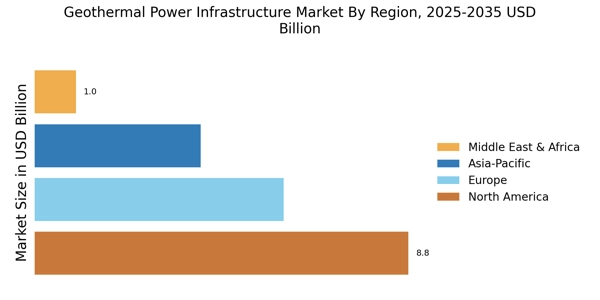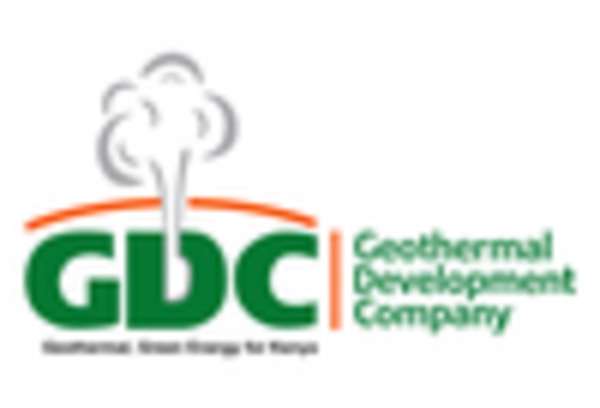Rising Energy Demand
The increasing The Geothermal Power Infrastructure Industry. As populations grow and economies expand, the need for sustainable and reliable energy sources intensifies. Geothermal energy, being a renewable resource, offers a stable supply that can help meet this demand. According to recent estimates, the energy consumption is projected to rise by approximately 30% by 2040. This surge in energy needs necessitates the development of geothermal power plants, which can provide baseload power generation. The Geothermal Power Infrastructure Market is thus positioned to benefit from this trend, as countries seek to diversify their energy portfolios and reduce reliance on fossil fuels.
Technological Innovations
Technological advancements are transforming the Geothermal Power Infrastructure Market, enhancing efficiency and reducing costs. Innovations in drilling techniques, such as enhanced geothermal systems, allow for the extraction of geothermal energy from previously inaccessible resources. Additionally, improvements in power plant design and operation have led to increased energy conversion efficiencies. The introduction of binary cycle power plants, which utilize lower temperature resources, expands the potential for geothermal energy utilization. As these technologies mature, they are expected to lower the levelized cost of electricity from geothermal sources, making them more competitive with other renewable energy options. This technological evolution is likely to drive further investment and development within the Geothermal Power Infrastructure Market.
Energy Security and Independence
Energy security remains a critical concern for many nations, driving interest in the Geothermal Power Infrastructure Market. As countries seek to reduce their dependence on imported fossil fuels, geothermal energy presents a viable alternative. It offers a stable and domestic energy source that can enhance energy independence. The ability to harness local geothermal resources reduces vulnerability to The Geothermal Power Infrastructure Market fluctuations and geopolitical tensions. Furthermore, geothermal power plants typically have long operational lifespans, providing a consistent energy supply over decades. This aspect of energy security is increasingly appealing to policymakers, suggesting that the Geothermal Power Infrastructure Market will continue to grow as nations prioritize self-sufficiency in energy production.
Environmental Sustainability Goals
The growing emphasis on environmental sustainability is a significant driver for the Geothermal Power Infrastructure Market. As climate change concerns escalate, many nations are committing to reducing greenhouse gas emissions and transitioning to cleaner energy sources. Geothermal energy, with its low carbon footprint, aligns well with these sustainability goals. The Geothermal Power Infrastructure Market is increasingly recognized for its potential to provide a reliable and eco-friendly energy solution. Reports suggest that geothermal power can reduce carbon emissions by up to 90% compared to fossil fuels. This alignment with environmental objectives is likely to spur investments and policy support, further propelling the growth of the geothermal sector.
Government Incentives and Policies
Government incentives and supportive policies play a crucial role in the growth of the Geothermal Power Infrastructure Market. Many countries have implemented favorable regulations, tax credits, and subsidies to encourage investment in renewable energy projects. For instance, various nations have set ambitious targets for renewable energy adoption, which often include geothermal energy as a key component. The International Renewable Energy Agency indicates that such policies can significantly reduce the cost of geothermal projects, making them more attractive to investors. As governments continue to prioritize energy security and environmental sustainability, the Geothermal Power Infrastructure Market is likely to experience accelerated growth due to these supportive measures.


















Leave a Comment